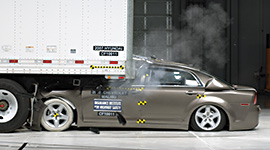When cars pass under a commercial truck trailer, the results aren’t pretty
According to the Insurance Institute for Highway Safety (IIHS), 70 percent of the 3,163 people who died in large truck crashes in 2009 were passengers in cars. Needless to say, a collision between a large truck and a car is a very dangerous type of motor vehicle accident but such a crash is even more dangerous when it is an under-ride collision.
The front ends of most cars today are built to manage the crash energies of a collision and minimize injuries but, in an under-ride crash, the car passes under the truck or trailer, often shearing off the roof of the car. As a result, the people in the car are usually killed or seriously injured, and decapitation is a serious threat.
This is especially true when the 18-wheeler’s under-ride guard fails. Even in low-speed collisions, people riding in passenger cars are at risk of serious injury or death if the under-ride guard fails.
A 1997 IIHS study estimated that half of all fatal crashes between large trucks and passenger vehicles involve under-ride. The study analyzed real-world crashes included in the Large Truck Crash Causation Study and found that many cases of severe under-ride involved large trucks and trailers that were exempt from under-ride-related safety standards. Researchers identified that in severe under-ride crashes where the large truck or trailer did have under-ride guards, the most common reason for under-ride guard failure was that the attachment between the guard and the truck was too weak.
So, even if it appears that the passenger car may have rear-ended the tractor-trailer rig, under-ride guard failure must be investigated.
The IIHS is currently petitioning the National Highway Transportation Safety Administration (NHTSA) for new regulations that will not only require under-ride guards to be strong enough to stay in place during a crash, but also will minimize the under-ride guard exemptions so that more large trucks and trailers are required to have such safety equipment.
The IIHS believes that in addition to revised regulations concerning under-ride prevention, testing of under-ride guards needs to be improved. However, current certification standards do not require that a complete system—trailer, guard, bolts and welding—be tested as a whole.
Until new regulations are in place that require more large trucks to have under-ride guards, and better ones at that, under-ride collisions will remain a very dangerous crash scenario that could happen to any passenger vehicle on the road. If you or a loved one has been involved in an under-ride collision, contact an experienced car accident attorney to learn about your legal rights.

